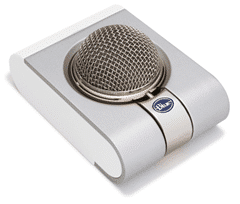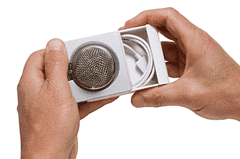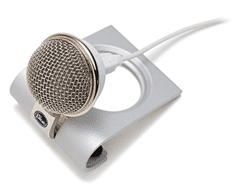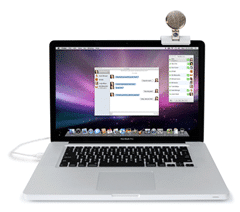Recently, I have tried to move my content beyond just the typed word (although it is my de facto method of doing a review). I have expanded to include videos using a variety of video capture devices (e.g., HD camcorders & screencasting software). Also recently, some other “daddy bloggers” and I have started a regular podcast (see CastofDads.com for the shows). Do you see a common thread here? The movement towards the spoken word.
While the camcorders and my computer have built-in microphones, sometimes those aren’t the most ideal to use, and frequently sound a bit tinny or scratchy. This is especially true when using a built-in mic on a laptop. I record most of my screencasts or other audio using a MacBook Pro (old one) and you can frequently hear the fans spinning in the background.
A few months ago, I pitched my sob story about not having an adequate microphone for recording audio to the folks at BlueMic (actually, their PR firm) and they donated a BlueMic Snowflake to my A/V cause (and I thank them).
Design
The first thing that struck me was the unique design of the Snowflake.
The entire microphone folds up from the base that also holds the USB cable.
The silver mesh microphone lifts out and the base is used to stabilize it on a flat surface.
Also the bottom part slides out so that the mic can be placed over a laptop screen.
I found this design to be very functional and convenient. Simply throw it in a bag and off you go. The design is also very rugged. I have had the Snowflake bouncing around in my bag for a few months and it looks good as new. All design aside, how well does the Snowflake work?
A Quick Test
It took me a while to figure out a good way to compare the performance of my MacBook Pro’s internal Mic versus the Snowflake. I tried a variety of programs like Audio Hijack Pro, Audacity and Audio Recorder since what I wanted to do was to find a way to record the audio from two sources simultaneously. Unfortunately, these applications just didn’t quite work the way I wanted them to. I ended up using WireTap Studio which has the ability to not only record from two sources but also edit the lossless audio to save one channel and then the other. (I actually simply zeroed out the volume of one source, saved the audio file, then reverted back to the original and did the same with the second source.)
Below are the two audio files that I created from one original recording.
Internal MacBook Pro Mic:
BlueMic Snowflake:
It should be pretty obvious that on the MacBook Pro mic, you can hear the fan noise fairly easily. I had the Snowflake position like the picture above (on the monitor) so that it was close to the computer as well. Ideally, you would place the Snowflake away from ambient noises (like fans) which you can do using the USB cable. The Snowflake sounded clearer, crisper and with a better range, simply, a bit more professional.
Obviously this is not a super “scientific” test but rather more of a real-world one. The Snowflake, even to the un-trained ear definitely produced a better quality. Note: other than changing which audio channel played, I did not modify the audio.
Tech and Other Specs
The Snowflake has some pretty basic system requirements (essentially you need plug-and-play USB capabilities), specifically:
- Vista or XP; USB 1.0 or 2.0; 64MB RAM (minimum)
- Macintosh: Mac OSX; USB 1.0 or 2.0; 64MB RAM (minimum)
From the BlueMic site:
- Transducer Type – Condenser, Pressure Gradient w/ USB Digital Output
- Polar Patterns – Cardioid
- Sample/Word Rate – 44.1 kHz/16 bit
- Frequency Response – 35Hz – 20kHz
Most of that is audio technical babble for me. The important thing is that the Snowflake is both Mac and PC compatible and doesn’t require any drivers to be installed to make them work. Just plug it in and it just works. You may have to tweak the gain a bit to boost the input’s volume, but that’s it!
The MSRP is $59.99 which is fairly reasonable for an external mic. Obviously, this is not a studio-quality microphone but for someone on the go who needs to record spoken audio for podcasts, VoIP calls or for audio-overlays in screencasting programs, you might want to keep the Snowflake on your shortlist. You can pick it up on Amazon for about $43.
DISCLOSURE OF MATERIAL CONNECTION: http://cmp.ly/2 My full review product review policy and disclosure can be found on the About page of my site.
HTD says: The Snowflakes compact design and solid audio performance makes it a good choice for speech-oriented recordings.







1 comment
Bkporack
This is a really good read for me, Must admit that you are one of the best bloggers I ever saw.Thanks for posting this informative blog.
USB KVM